Dive into the magnificence of Mexico’s Merida
Mayan and Spanish heritage blend enticingly in Yucatan dance, food, handcrafts and markets.

The Plaza de la Indepencia in Merida has a huge sign announcing its name. Many Mexican towns boast similar signs on their central plazas. (Janet Podolak)
Merida is not the Yucatan you thought you knew.
Not touristy like Cancun or the Mayan Riviera, the capital of Mexico’s State of Yucatan was built atop an existing Mayan city in 1542 and named after the Spanish hometown of its founder, Francisco de Montejo. Today’s Merida is an ideal place to experience and celebrate Yucatan’s unique culture, music, markets and great food. It’s also a headquarters for forays to the Gulf of Mexico coast and surrounding villages. Weather, which can be steamy in spring and summer, is ideal this time of year.
Be sure to include a Sunday in this easy-to-reach destination — that’s when locals and visitors alike dress up and mingle in the city center, where streets are closed. Vendors set up stalls, and free performances of music and dance take place throughout the day. During my November visit, I most enjoyed sitting on Plaza de la Independencia, ringed by colonial buildings including the Catedral de San Ildefonso, for wonderful people watching. One man, doctor-like and dressed all in white, offered blood-pressure checks for a few pesos.
The Cathedral, which is one of the oldest buildings on the continent, was built in 1598 from stones taken from Mayan structures. Evidence of both Mayan and Spanish cultures is apparent in everything from food to architecture throughout the Merida area.
I was surprised to see French-style manors in the heart of the city, but, it turns out, those who built the mansions in the late 1800s were wealthy sisal millionaires who admired everything French and sought to imitate it. Worth visiting nearby is the Casa de Montejo, built in the mid-1500s and home for 13 generations of the founding Montejo family until it was sold to a bank in 1980. The bank fills the back of the mansion, while visitors tour the front rooms, gazing at furnishings imported from France more than a century ago.
Be sure to make time to visit the vast Mercado Municipal, a block-sized market building layered with scents, colors and flavors. On the first floor, you’ll find everything from neatly stacked fruits and vegetables to religious icons, herbs and spices to animal parts hanging from above.

A colorful array of handcrafted hammocks and embroidered bags are among the shopping finds at Merida’s huge two-story market. (Janet Podolak)
Upstairs is folk art from around the country along with colorful handwoven hammocks, hand-embroidered clothing, sandals and sisal fans. Dozens of small restaurants are found on both levels, where a two-course meal with a drink can be found for about $3.
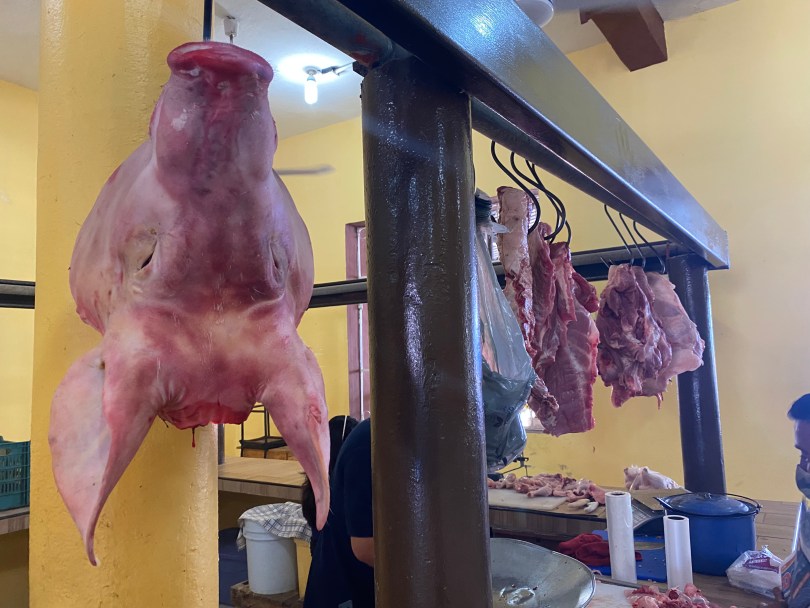
A pig’s head and other animal parts is among the meats to be found on the first floor of the mercado. (Janet Podolak)
Sisal is a rope-type textile, also called henequen, and still is made from parts of the agave cactus. Called “green gold” during last century, its production from the labors of Mayan slaves 150 years ago made descendants of the Spanish founders very wealthy, resulting in economic prosperity for the entire region. Many of the gracious haciendas built for henequen plantations are today elegant lodgings in the Merida countryside.
Shipping of sisal led to the construction in 1856 of a port at Progreso, 20 miles away on the Gulf of Mexico. Today, it’s a popular beach resort with restaurants and cafes lining its long beachside walkway. Cruise ships call here a couple times per week. Its sand is coarser and the water not as blue as on the Caribbean side of the peninsula, but Progreso’s water is shallow for quite some distance, and it makes for a fine beach day from Merida. It’s the shallow water, in fact, that’s the reason for its 2-mile-long pier.
Izamal, a colonial town about 20 miles east of Merida, also is worth a visit. As with other towns in Yucatan, you will know you’ve arrived when you pass beneath a large arch at the city limits. It’s mustard-colored, like almost every building in town, a legacy from the time in 1993 when Pope John Paul II visited Izamal and city fathers decreed that his favorite color was to be memorialized.
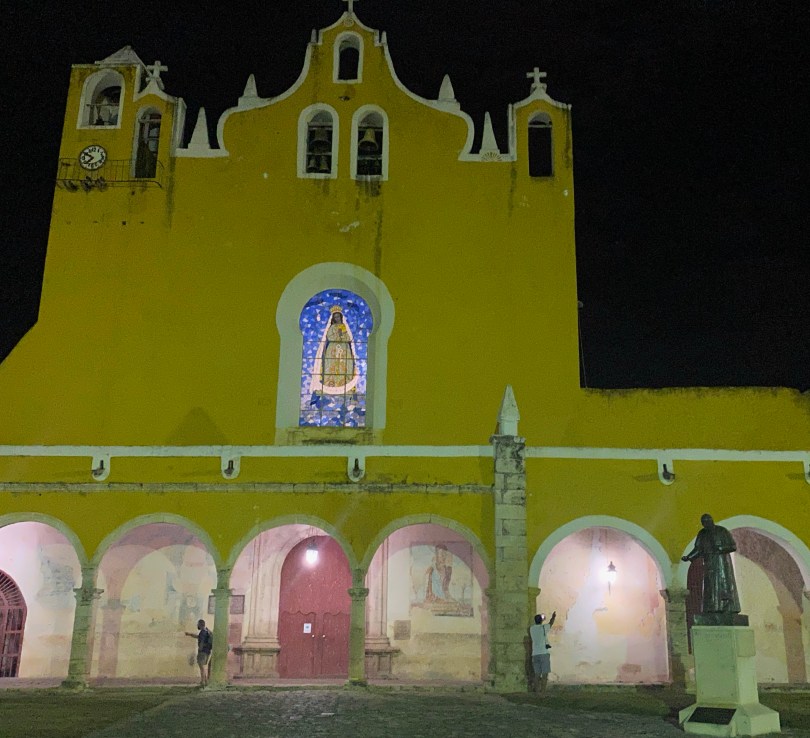
A statue of Pope John Paul II commemorates his 1993 visit to the mustard-yellow convent at Izamal. (Janet Podolak)
The mustard-yellow Convent de San Antonio de Padua, completed in 1562 atop one of the largest Mayan pyramids, long has been a place of religious significance to the Roman Catholic Mexicans. But it was a Mayan pilgrimage site long before they arrived. Stones from that pyramid were used in its construction, and Mayan glyphs still can be found by sharp-eyed visitors in the convent’s walls.
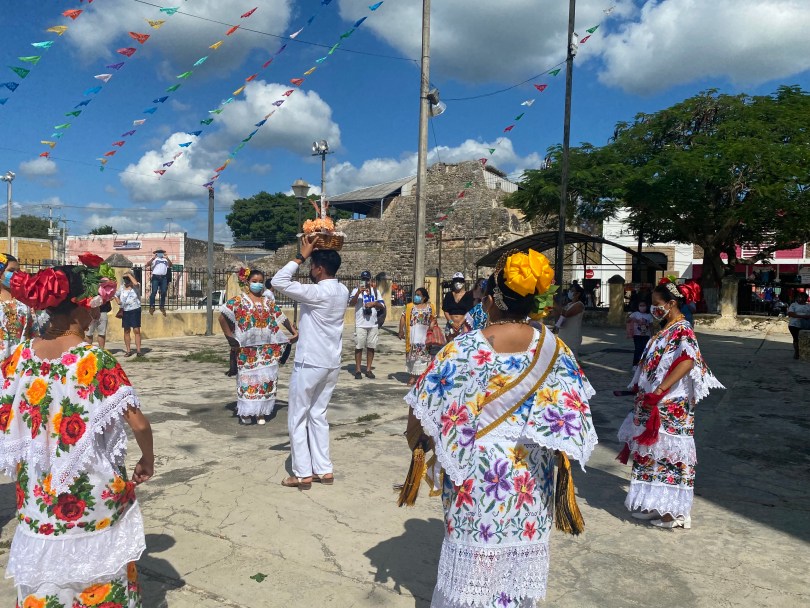
An ancient Mayan pyramid is the backdrop for these dancers outside a village church near Merida. (Janet Podolak)
A statue of Pope John Paul II stands in the 84,000-square-foot grassy atrium at the front of the convent. It’s said to be the largest atrium on this continent, second only to St. Peter’s at the Vatican.
One of the best meals of my life was enjoyed at Micaela Mar y Lena, near the city center of Merida, where a wood-grilled Mayan octopus was served with blackened sweet potato, avocado puree and cilantro after an appetizer of Kumamoto oysters in the half shell and butter clams.
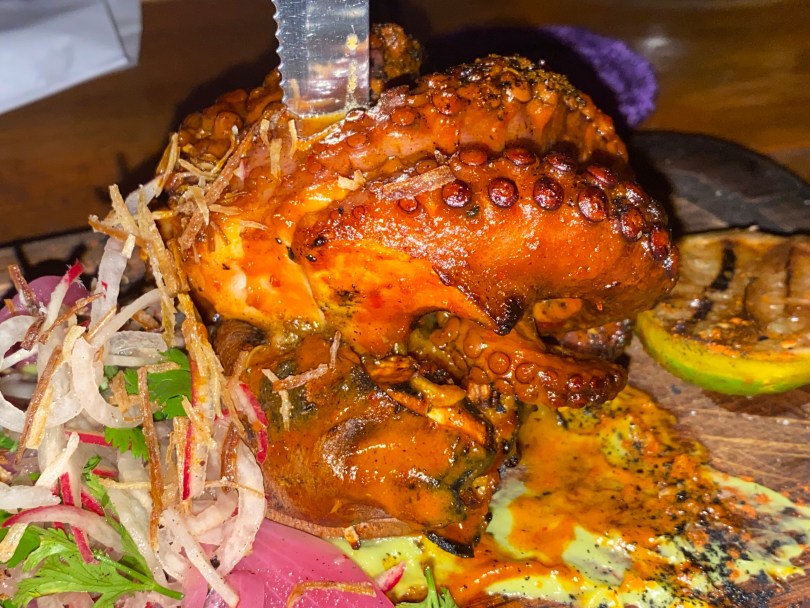
Wood-grilled octopus served with blackened sweet potato, avocado puree and cilantro is a treat at Micaela Mar y Lena in Merida. (Janet Podolak).
A poem from the diary of Micaela, the great grandmother of one of the owners, is inscribed on the wall, asking us to remember the color of the sea and feel of the firewood — both major components in the creative seafood served here.
This establishment even makes its own mead from the honey of the Yucatan’s stingless honey bee. Instead of being sweet, as expected, its flavor is dry — consistent with the surprises found around every corner in this delightful part of the Yucatan.
It’s smart to rent a car to travel to surrounding villages such as Izamal or the port of Progreso, but Merida is well served by public transportation.
Visit the informative visitmerida.mx and get a translation.
VisitMexico.com is another valuable resource for Yucatan information as is yucatan.travel.
The US dollar buys more than 20 Mexican pesos. Discover how to cool off in Yucatan’s cenotes from last month’s story ‘Cenotes, sacred to the Mayans‘.

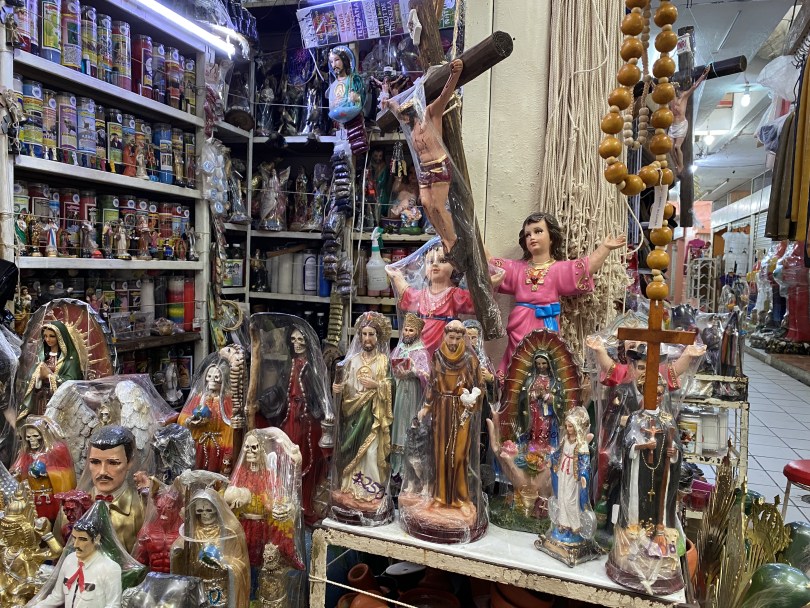




Recent Comments